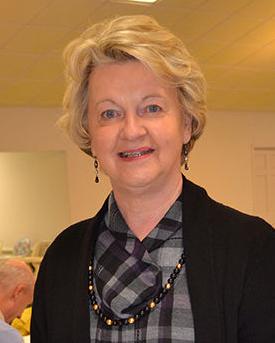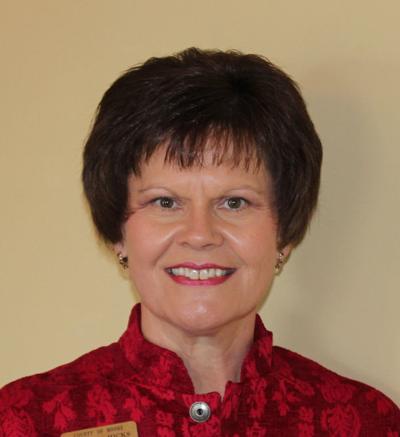Southern Pines has been ground zero for much of the transformative growth in Moore County in recent years. How to manage this ongoing development pressure — while keeping taxes low and infrastructure needs in check — are some of the top issues facing four candidates vying for two open seats on the Town Council.
Current council member Mike Saulnier is running for a full four-year term after first being appointed two years ago to fill a vacancy. He is joined on the ballot by three other first time candidates: Taylor Clement, Brandon Goodman and Ann Petersen.
Following is a brief look at the candidates, in alphabetical order, and what they hope to accomplish if elected.
Taylor Clement
Describing Southern Pines as the “quintessential melting pot,” Taylor Clement said her hope is that the culture-rich community will continue to appeal to newcomers, thus generating more growth. As a young mother, wife, and co-owner of Casino Guitar, a downtown Southern Pines business, she believes the town will benefit from a diversity of voices in leadership roles.
“I feel there is a responsibility for our community to step up and help,” she said. “We have something worth working for. I see this as a service to the community. I hope I can use my background, my experience and my skills to the greater good…I want to make sure the town remains a place we love so that people can continue to benefit from it the same way we have, the same access to meet their dreams.”
Clement also serves as treasurer and acting secretary of the Moore Montessori Community School board. In this role, she was closely involved in the public charter school’s efforts to acquire and repurpose the former Southern Pines Elementary School campus on May Street last year. That work inspired her to run for town council.
“We must proactively set goals for how we grow. We know the developers are coming,” she said, singling out USGA’s Golf House Pinehurst and the proposed Target-anchored retail center as major new influences on the area. “We can’t just shut the door. I want to make sure we have control over how (growth) happens.”
Change, she added, is not necessarily a bad thing. It is when the pace of growth exceeds proper planning. “I don’t like the catch-up game. You can’t build for current needs, you have to build for the future,” offering up the example of the new Southern Pines Elementary School campus, which includes adequate land and an architectural design that will accommodate expansion when needed.
In addition to the new school off Morganton Road, other development interests include a burgeoning biosciences campus, the proposed Target shopping center, new apartments and more proposals in the pipeline, a potential YMCA facility, and redevelopment of a key town-owned property. All of these projects will bring opportunity and challenges.
Reflecting on West Southern Pines and concerns by residents of the historically Black neighborhood that this growth will drive up property values, resulting in high taxes, Clement views that outcome as an asset, not a hindrance.
“Protecting a community doesn’t mean boxing it up and saying we won’t change. Those families deserve to participate in this growth and they need to understand how this can benefit them…There is something between a ‘want’ and a ‘do.’ What is good for West Southern Pines is good for us all.”
Clement recommends that a closer look at existing zoning in areas anticipated for future growth, such as South Carlisle Street, should be done now. That would ensure the community has more say in how it is developed in the future.
She also sees room for improvement in the town’s planning and inspections procedures to make sure residents and small business owners are treated with the same attention given to big projects.
“Fast growth is all about how fast, how cheap, and how much money a developer can get out of a project. There is no heart to it. At this point, and we are at a pivotal point, we need to take time to plan so we maintain that heart, that character.”
Brandon Goodman
A custom home builder and business owner, Brandon Goodman said the one common concern he hears about is growth. Like Clement, he did not have strong political aspirations but decided his professional experience and knowledge of land use and zoning was a useful skill set he could bring to the table.
“Our county didn’t have a transportation plan until the last year or so. That was a huge failure,” he said, noting that Southern Pines’ daily population swells to 50,000. “The reality is we didn’t build (adequate) roads and now we don’t have the transportation infrastructure in place when we need it.”
In a similar vein, he believes the town has missed opportunities to develop small area plans and so-called “overlays” that could have encouraged better designs in some of the more recent projects.
“The town’s zoning code is outdated. I think we need to take a hard look and, as part of that, place a higher emphasis on physical form like walkability and sustainability, and less emphasis on use.”
He cautioned that Morganton Road development, unchecked, will bring the same traffic congestion that people see — and attempt to avoid — on U.S. 15-501 and U.S. 1. The town should be engaging N.C. Department of Transportation and state leaders to see what improvements can be done now. “It is shortsighted to not look at the long-term impacts that this growth will have on Morganton Road.”
He also said the town shouldn’t “default to hiring more personnel and raising taxes,” in response to growth demand without looking at ways to reposition existing resources to achieve goals.
“It is hard to defend growth when the property owners are doing a bigger job of funding local government than they were just a few years ago,” noting property taxes provide around 60 percent of the town’s incoming revenue. “This is a trend that needs to reverse, especially with all this commercial growth.”
When it comes to West Southern Pines revitalization efforts, Goodman said he fundamentally disagrees with the idea that increasing property tax values is a bad thing for the community.
“The majority of most Americans’ biggest asset is their home. My argument is we need to manage our (town) budget better so we can keep property taxes low, not try to keep property values low,” adding that higher land values also make it harder for a developer to come in and buy land the community hopes to protect. “Increased property values is a way to fight gentrification as long as you have a commitment from the town to keep property taxes low.”
Goodman said that another idea to increase the viability of West Southern Pines is to use a portion of the former Southern Pines Primary School campus as a future town administrative building. The Board of Education recently approved the sale of the 16-acre property to the Southern Pines Land and Housing Trust. Town leaders are expected to conduct a public hearing in November to consider a $160,000 contribution with the expectation of repurposing the school’s Blanchie Carter Discovery Park into a public recreation facility.
“A town hall in West Southern Pines would get rid of the clear divide between east and west. It would put staffing there and that hopefully would drive more investments, such as restaurants and shopping that we would all support as much as Broad Street.”
“I believe all of us — that is, the candidates and all of the citizens — can adequately identify the problems. That is the easy part. The hard part is to identify the solutions.”
Ann Petersen
A retired educator and former lawyer, Ann Petersen garnered the most votes in the Southern Pines primary election held earlier this month that narrowed the field of candidates from five to four. And while this is her first time on a ballot, she said she’s looked forward to this opportunity for over 10 years. It was simply a matter of waiting until she had the time to focus on the job.
“As a concerned citizen, I’ve seen that when a development proposal comes in, it is an unequal playing field,” she said, noting the town’s quasi-judicial public hearing process follows state law. “The developer brings in their lawyer and the town council acts as judge, but there is no cross-examination process.”
A wealthy group of neighbors opposed to a specific project may have the means to hire a lawyer to represent their interests; however, not every community can do that.
“There is no voice for the constituents and that concerns me. That concerns me a lot,” Petersen said, suggesting fixing the problem would likely require a town partnership to hire a pro bono or reduced-rate attorney. “I recognize our hands are tied by the state legislature, but there is potential for improvements to the process that can be made.”
On the topic of growth, specifically the transformational growth along Morganton Road, Petersen said “that train has left the station.”
“That land along the road was bought over 30 years ago for development. We don’t want to be stagnant and not grow…but I’m concerned about how our downtown shopping will be impacted.”
She also questioned the traffic analyses that are provided by developers, as part of the approval process, that often lean favorably toward their project. Petersen said she’d like to see the state legislature allow towns to require an environmental impact report as part of any major proposal as well.
On West Southern Pines revitalization efforts, Petersen believes town leadership are acutely aware of the different issues and concerns. “But there is a Catch-22. The ordinance says the only reason you can block development is if the property values diminish. But if people (affected by nearby development) in the town see their property taxes triple, as a result increased property values, then they can’t afford to fix up their houses.”
Petersen said the late Fred Walden, a longtime town councilman and founder of the Southern Pines Land and Housing Trust, had the answer. “He understood the need to protect the West Southern Pines culture and history, and understood the need for affordable housing, and that this could not be done by the council alone. It had to be done through partnerships with nonprofit organizations.”
Petersen and her late husband, Bruce Cunningham, were deeply invested in the development of the Blanchie Carter Discovery Park at the former West Southern Pines Primary School campus. She said that legacy has sometimes made it harder to keep her emotions in check, but her hope is the community will revitalize to a point of self-sufficiency.
“I am so invested that I feel sometimes like I have to check my heart at the door…My heart is there and I want to take my good judgement with me there as well,” Petersen said. “I would love to see their livelihoods, those businesses, that freedom and support to reestablish that.
“Southern Pines is heterogeneous…and we have so many smart people here. You have all this talent. We have this incredibly interesting and diverse downtown. There is nothing boring about our town.”
Mike Saulnier
A retired 30-year career military officer and garrison commander, Mike Saulnier served three years on the town’s planning board, then was appointed to the Town Council two years ago. He is running for election for the first time.
“We have a challenge to manage growth, not to revive a town like so many other cities you see around. So how do we manage the number one micropolitan in North Carolina? People want to come here, they like it here,” Saulnier said, noting his last few years on active duty were spent, in essence, in city planning and management. “The way I look at everything we do on the council and when I was on the planning board is through the lens of ‘community first.’”
That involves looking at how a project will impact the people, whom he describes as the town’s greatest asset. “If it’s not a positive impact, then we need to talk about why this project is needed.”
Saulnier said the town is landlocked with a small general business district. That means land and how it is used are a more precious commodity. “Just because we have an open space doesn’t mean that we should let “whatever” come in,” he said.
New proposals are reviewed based on the town’s land use plan, a stringent code of ordinances, and comprehensive long range plan. The town’s infrastructure is also watched closely by the town council and administration. Saulnier noted that planning ahead for growth also means making sure new development doesn’t outpace town services. Some departments such as police, require a longer lead time to recruit and train staff.
“Southern Pines gets a lot of traffic from shoppers and tourism. We swell to around 50,000 people in town on any given day. We have to cover all of that. If you get in a car accident, it doesn’t matter whether you are from town or wherever: our police have to respond.”
On the Morganton Road corridor, Saulnier said there are some exciting plans being set, such as a potential new YMCA and the Target shopping center and new parkway road that will improve connectivity and walkability in the community.
Reflecting on the impacts that growth will have on West Southern Pines, Saulnier said “we are one town, not two towns. I know the history…gentrification has no place in our town. We have to build trust first and we do that through action, not talking about it.”
One of the biggest challenges in protecting and preserving the historically Black community is resolving heir properties, where you have a single lot with ties to multiple descendents. Saulnier said there is a process where divided ownership properties can be assisted, but that requires legal assistance with documentation.
“If we don’t build the foundation by resolving these kinds of root problems, it will all fall down,” he said. “My concern is you have homeowners and renters, and out-of-town property owners. There are the people that give West Southern Pines its character and traditions. We need to figure out a way that they don’t get pushed out. We have to get all of these people all-in on this.”
Looking at budgeting and big picture ideas, Saulnier said town leaders have to stay focused on needs versus wants. “I have no problem with needs. I’m not afraid of raising taxes for needs, if we need to. But I am vehemently opposed to raising taxes for wants.
“I never had the luxury of a hometown. My dad was in the military and then I was in the military. When I retired, my wife and I went looking for a hometown and we found it. When people ask me where I’m from, I tell them Southern Pines.”




